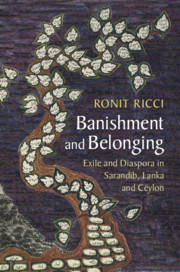Book contents
- Banishment and Belonging
- Asian Connections
- Banishment and Belonging
- Copyright page
- Contents
- Figures
- Maps
- A Note on Orthography and Manuscripts
- Acknowledgments
- Abbreviations
- Maps
- 1 Introduction
- 2 Diasporic Crossings: Malay Writing in Nineteenth-Century Ceylon
- 3 Remembering Java
- 4 “Ceyloned”: The View from the Other Shore
- 5 Exilic Journeys in Time, Place and Writing
- 6 Nabi Adam: The Paradigmatic Exile
- 7 Banishment and Interreligious Encounters: A Malay Ramayana
- 8 Ceylon Malays: Military and Literary Paths
- 9 Malay Writing in Ceylon: Roots and Routes
- Glossary
- Bibliography
- Index
9 - Malay Writing in Ceylon: Roots and Routes
Published online by Cambridge University Press: 11 November 2019
- Banishment and Belonging
- Asian Connections
- Banishment and Belonging
- Copyright page
- Contents
- Figures
- Maps
- A Note on Orthography and Manuscripts
- Acknowledgments
- Abbreviations
- Maps
- 1 Introduction
- 2 Diasporic Crossings: Malay Writing in Nineteenth-Century Ceylon
- 3 Remembering Java
- 4 “Ceyloned”: The View from the Other Shore
- 5 Exilic Journeys in Time, Place and Writing
- 6 Nabi Adam: The Paradigmatic Exile
- 7 Banishment and Interreligious Encounters: A Malay Ramayana
- 8 Ceylon Malays: Military and Literary Paths
- 9 Malay Writing in Ceylon: Roots and Routes
- Glossary
- Bibliography
- Index
Summary
This chapter expands further on the documentation of the Malay experience in Ceylon and its forms of writing. It asks how the Malay presence in Ceylon was made sense of, remembered, and consolidated into a meaningful experience that would be passed down through the generations; it considers the always-complex diasporic condition and the gaps and silences inherent in its archives, viewing Malay diasporic life and writing as loosely forming a vernacular frontier of language, culture and religion. The chapter draws on a wide range of sources from the nineteenth century but highlights especially the figure and writings of Baba Ounus Saldin (b. 1832): author, publisher, editor and religious leader. Reading two of his works side by side, one a history of the Malay community explicitly aimed at a younger generation (Syair Faid al-Abad), and the other containing his personal and family memories (Kitab Segala Peringatan), suggests a pattern of Malay identity in late nineteenth-century Ceylon that combined strong Islamic sentiments with pride in the Malays’ contribution to imperial wars. The chapter concludes by considering the Malays’ movement “forward” from people of mixed, diverse backgrounds toward becoming “Malay,” but also “backwards,” through their writing, to those multiple roots and routes.
- Type
- Chapter
- Information
- Banishment and BelongingExile and Diaspora in Sarandib, Lanka and Ceylon, pp. 218 - 250Publisher: Cambridge University PressPrint publication year: 2019



